Key takeaways:
- Gender equality has historical roots with significant milestones, including the suffragette movement and the women’s liberation movement, but systemic challenges remain.
- Key challenges include unconscious bias, underrepresentation in leadership, a persistent pay gap, and disparities in access to resources.
- Adopting inclusive policies and promoting open conversations are essential strategies for fostering true equality in workplaces and society.
- Personal actions, such as amplifying women’s voices and supporting women-owned businesses, contribute to advancing gender equality on an individual level.
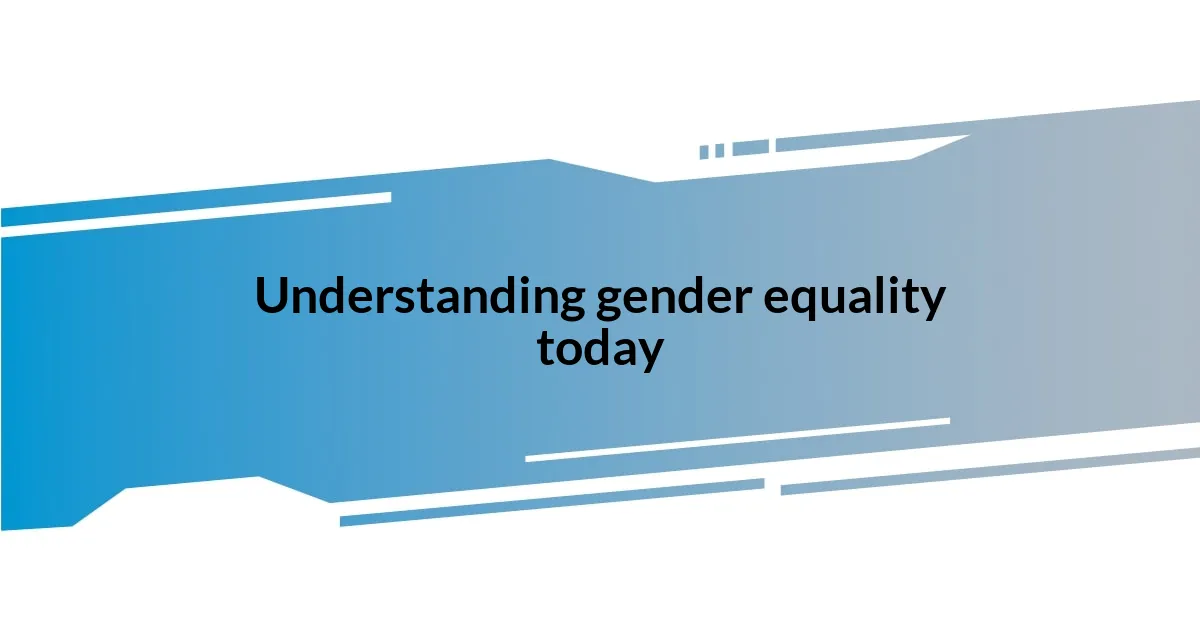
Understanding gender equality today
Understanding gender equality today requires us to recognize not just the progress that has been made but also the barriers that still exist. I remember attending a workplace seminar where women shared their experiences of being overlooked for promotions despite having the qualifications. It left me questioning: how can we claim to be progressive if systemic biases still dictate opportunities?
In everyday conversations, I’ve noticed that some people still associate certain roles or hobbies with a specific gender. For example, when a friend remarked that “girls shouldn’t be mechanics,” I felt a mix of frustration and concern. This reflects a broader societal mindset that reinforces outdated stereotypes. Isn’t it time for us to confront these ingrained beliefs and redefine what’s possible for everyone, regardless of gender?
As I reflect on my interactions, I worry. While discussions around gender equality are more common now than ever, are we truly creating an inclusive environment? For instance, I’ve seen companies promote their commitment to diversity but often fall short in real change. This discrepancy makes me wonder: are we checking boxes, or are we genuinely fostering an equitable society? The importance of understanding gender equality today goes beyond theory; it requires action and accountability from all of us.
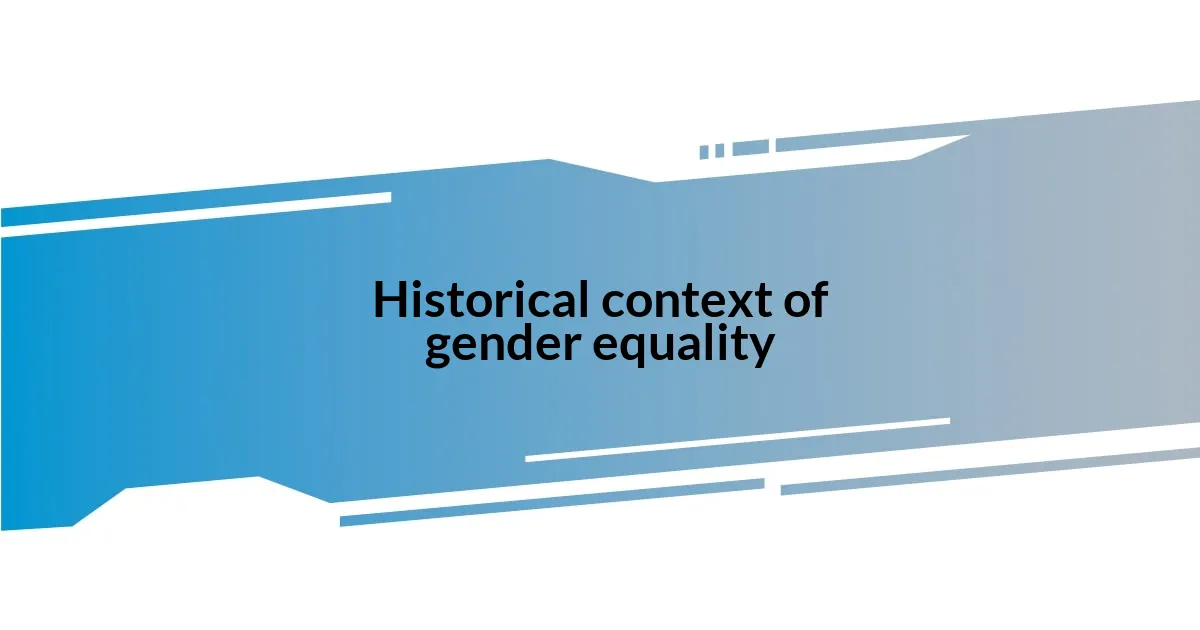
Historical context of gender equality
The struggle for gender equality has deep historical roots, extending back centuries. For a long time, women were primarily relegated to domestic roles, with limited access to education or professional opportunities. I remember reading about the suffragette movement and how women risked everything to gain the right to vote, which really highlighted the monumental shifts that occurred when individuals united for a common cause. Their bravery ignited conversations that resonate even today.
In the 20th century, significant milestones began shaping the landscape of gender equality. The women’s liberation movement of the 1960s and 1970s was pivotal in redefining women’s rights across various spheres, from workplaces to reproductive rights. Thinking about this era reminds me of my grandmother, who fought for her right to a career instead of conforming to traditional expectations. Her stories filled me with a sense of connection to a powerful legacy of resilience and determination, making me appreciate how far we’ve come.
Fast forward to contemporary society, and we see both progress and ongoing challenges. Despite historical advancements, systemic issues still persist, and equal representation remains elusive in many arenas. Reflecting on my own experiences, I’ve had conversations where individuals dismiss the idea of gender discrimination as a relic of the past. But I often counter that, while laws may have changed, societal perceptions and biases can linger. It’s this complexity that makes understanding the historical context of gender equality essential in navigating today’s landscape.
| Period | Key Developments |
|---|---|
| 19th Century | Suffragette movement begins, advocating for women’s voting rights. |
| 20th Century | Women’s liberation movement leads to broader rights in education and employment. |
| 21st Century | Ongoing discussions surrounding gender pay gaps, representation, and systemic biases. |
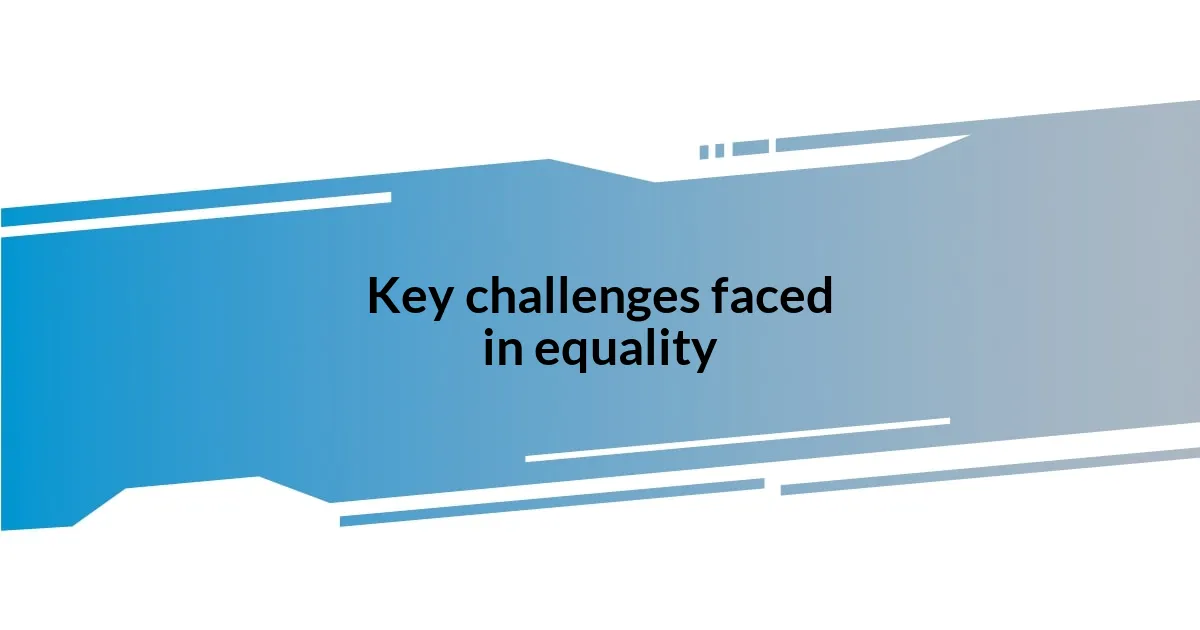
Key challenges faced in equality
It’s clear that despite strides toward equality, several key challenges continue to hinder genuine progress. One notable issue is the persistence of unconscious biases that affect hiring and promotion decisions. I recall a time when a friend, freshly graduated and bursting with talent, was overlooked for a crucial project simply because her supervisor felt more comfortable with the male candidates. Experiences like this make me wonder how many capable individuals are being sidelined due to outdated perceptions.
Here are some of the challenges we still face:
- Unconscious Bias: Many employers may not even realize they hold biases that influence their decisions.
- Representation in Leadership: Women and non-binary individuals are still underrepresented in leadership positions across various sectors.
- Pay Gap: Despite improvements, a significant gender pay gap persists, meaning women often earn less than their male counterparts for similar work.
- Work-Life Balance: Traditional expectations about gender roles in caregiving can limit opportunities for working women.
- Access to Resources: There is still a disparity in access to education and professional development opportunities for marginalized genders.
I’ve been in conversations where people argue that gender equality is largely achieved, but I can’t shake the feeling that these challenges highlight how much work lies ahead. Reflecting on these hindrances strengthens my belief that awareness and proactive measures are crucial if we ever want to achieve true equality.
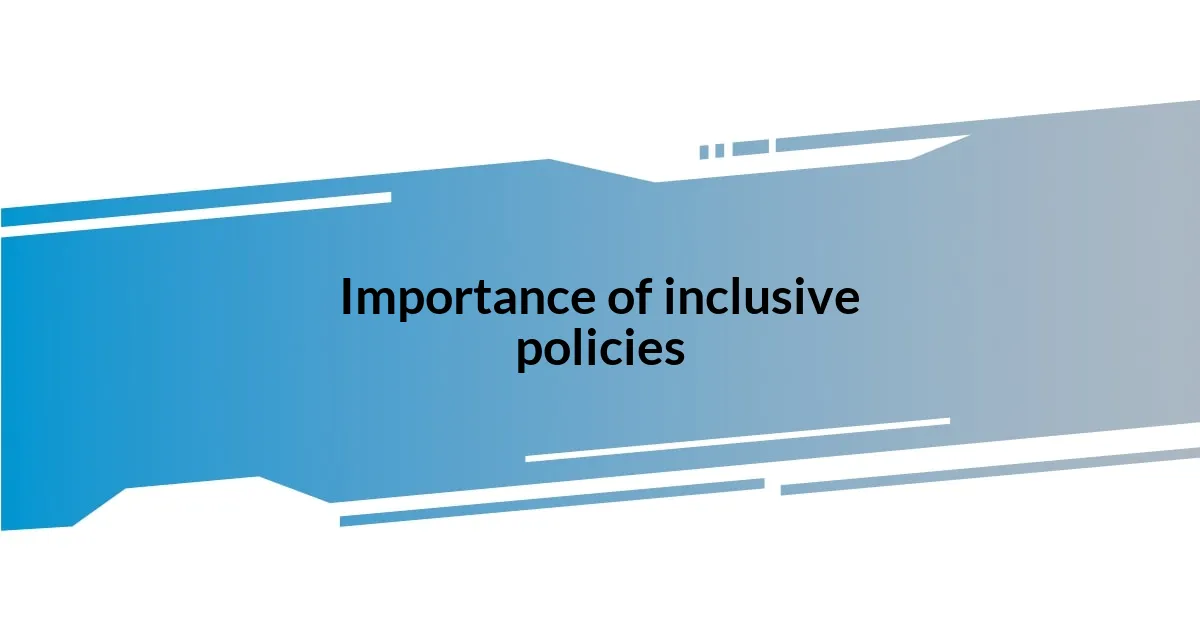
Importance of inclusive policies
Inclusive policies are pivotal because they create environments where everyone can thrive, regardless of gender. I remember my own workplace’s shift towards inclusive practices; it was a game changer. Suddenly, we had flexible schedules and training programs tailored for marginalized groups. It felt like a breath of fresh air, allowing for greater collaboration and creativity as diverse perspectives were welcomed.
Moreover, these policies don’t only benefit individuals; they also contribute to the overall success of organizations. When companies prioritize inclusivity, they often see improved performance and innovation. I’ve seen firsthand how teams with varied backgrounds come up with solutions that are far more comprehensive than those in more homogenous groups. Isn’t it fascinating how diversity can directly impact a company’s bottom line?
Ultimately, adopting inclusive policies is crucial not just for ethical reasons but also for societal growth. I often think about how many talented voices go unheard simply because their experiences don’t align with traditional norms. By fostering inclusion, we can dismantle barriers and create opportunities for everyone. Isn’t it time we embrace these strategies for a more equitable future?
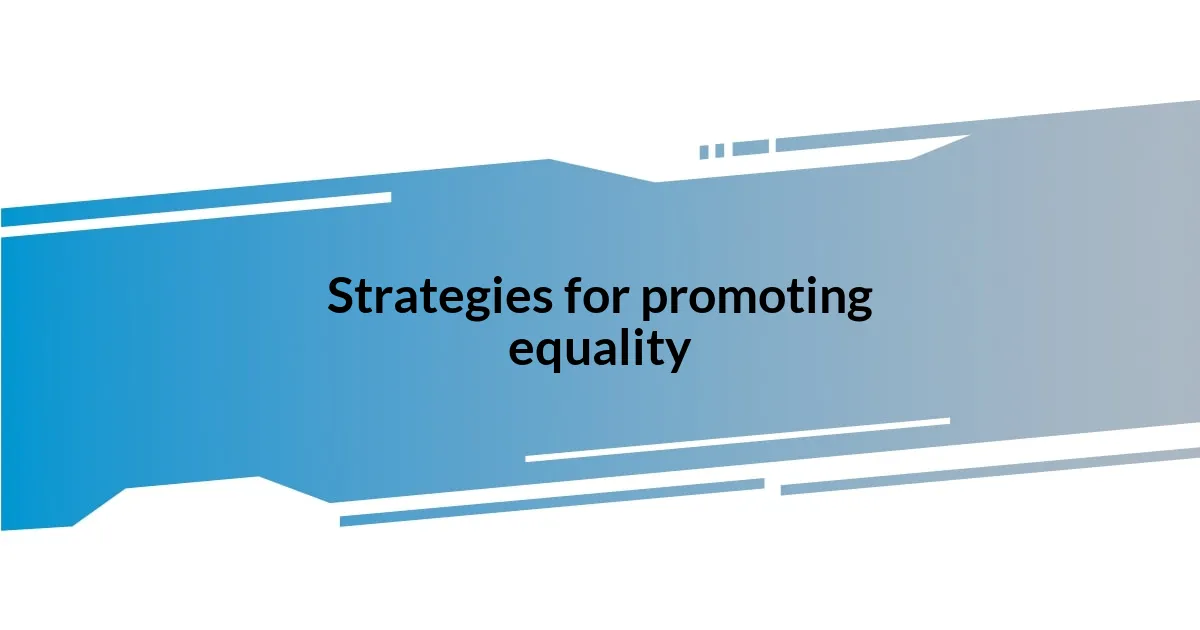
Strategies for promoting equality
One effective strategy for promoting gender equality is implementing mentorship programs that connect aspiring women and non-binary leaders with experienced professionals. I once participated in a mentorship initiative, and I can’t express how transformative it was for my career. Having someone to guide me through the intricacies of my field not only boosted my confidence but also opened doors I never knew existed. Isn’t it incredible to think how a simple connection can empower individuals and help pave their paths to leadership?
Another crucial approach is to actively promote open conversations about gender biases and disparities within organizations. I remember leading a workshop at my company where we discussed the significance of recognizing our biases. The room was filled with honest reflections and surprising admissions, and it became clear that many were unaware of how deeply ingrained these issues could be. Creating a safe space for dialogue not only fosters understanding, but it also helps teams identify specific changes they can implement. How often do we shy away from discussing difficult topics because they seem uncomfortable?
Finally, enforcing transparent hiring practices is vital in eliminating biases that skew selection processes. I’ve seen the positive impact of blind recruitment strategies, where names and gender identifiers are removed from resumes. It always amazed me how many candidates rose to the top purely based on skills and experience, rather than perceptions based on gender. It just goes to show how tangible changes in processes can lead to more equal opportunities. Can you think of the untapped potential waiting to be discovered with such approaches?
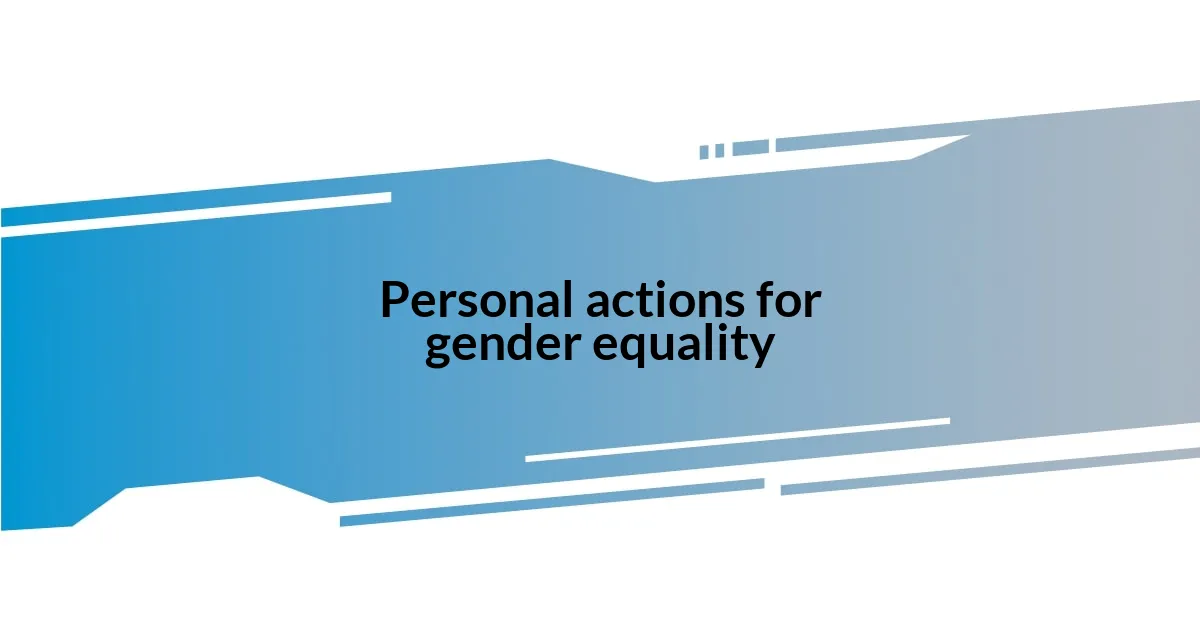
Personal actions for gender equality
Taking personal action for gender equality often starts with the little things we do every day. For instance, I’ve made it a priority to amplify women’s voices in discussions and meetings. I recall a time when a colleague shared a brilliant idea that didn’t receive the attention it deserved. I felt compelled to highlight her contribution, and doing so not only empowered her but also reminded the team of the wealth of ideas that can come from diverse perspectives. Isn’t it amazing how simple recognition can create a ripple effect of confidence?
Moreover, I actively seek out opportunities to support women-owned businesses. Each time I purchase from these enterprises, it feels like I’m contributing to a greater cause. I remember the joy of attending a local female entrepreneur fair, where I met passionate individuals who were breaking barriers in their industries. Patronizing such businesses isn’t just about a transaction; it’s about uplifting a community and encouraging others to challenge the status quo. How often do we consider the power our choices hold in fueling change?
Volunteering for organizations focused on gender equality is another impactful step I’ve taken. One such experience had me engage with young girls through STEM workshops, where I witnessed firsthand the transformative power of mentorship and encouragement. Seeing their eyes light up with curiosity and ambition was nothing short of inspiring. It made me realize that we can cultivate the next generation of trailblazers, and that investment in their potential is an investment in a more equal future. What if more of us dedicated time to shape the dreams of future leaders?